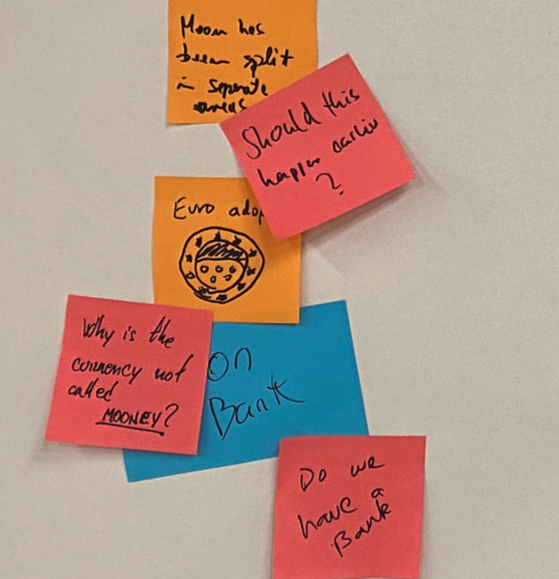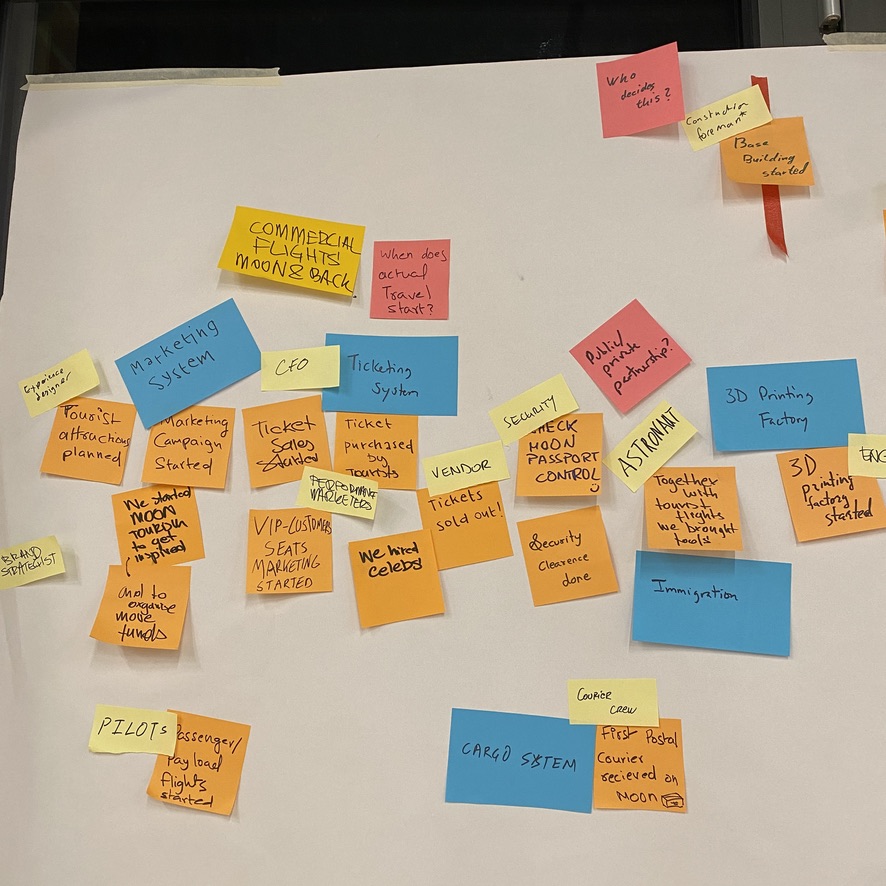-> Synchronizing mental models <- and a talk with Germany’s first astronaut Ulf Merbold

EventStorming is a flexible workshop format for collaborative exploration of complex business domains. It sounds fun, and it was fun. Imagine bringing 25 people together for 3 hours to use this popular technique to model a solution to a problem in that domain.
Wikipedia:
Event storming is a workshop-based method to quickly find out what is happening in the domain of a software program. Compared to other methods it is extremely lightweight and intentionally requires no support by a computer. The result is expressed in sticky notes on a wide wall.
The business process is „stormed out“ as a series of domain events which are denoted as orange stickies. It was invented by Alberto Brandolini in the context of domain-driven design (DDD). Event storming can be used as a means for business process modeling and requirements engineering. The idea is to bring together software developers and domain experts and learn from each other.[3] The name was chosen to show that the focus should be on the domain events and the method works similar to brainstorming or agile modeling’s model storming.
Meet-Up Time! This time it was an in-person meeting organized by Thought-Works and the Domain-Driven Design Group in Berlin. It felt amazing to be back in a room with around 25 like-minded souls — mostly developers and architects (my educated guess) who came together for a high-paced, very active practice session, led by Steven and Marco.

Our topic:
–> The colonisation of the moon!
Eventstorming, with its fuzzy and very chaotic structure, is a brilliant method for synchronising mental models about a specific topic. I was already part of an online session at my previous job. The fortune of being in a room together is undeniably better for this kind of activity. Or have you ever experienced the the incredibly satisfying feeling of crumpling up a PostIt and thrown it on the floor in an online workshop?
I don’t want to get deep into the process; there are several videos and websites out where you can have a look at. I just want to point out the main 6 phases in my own words. And I want to invite you to practice it with your teams.
Phase 1: Hack the space:
We need a LOT of space on the wall/windows for all the ideas. Remove the chairs and desks so people can move around and dance.

Phase 2: Define the events:
Everyone grabs PostIts (the same color!) and a sharpy, and let’s get wild. Just write whatever comes to your mind about the problem we want to solve. Make sure there is a good problem statement beforehand. Every idea, 1 PostIt. Write it in past tense, like: „First batch of build-up crew landed on the moon“. This is what is called an EVENT.

Phase 3: Questions / Hot Spots:
Now, it’s time for the people to slender along the wall, read the events, and add questions to the ideas written on PostIts in a different color than the event. This is called HOT SPOTS here.

Questions were just added on stickies (different colors, discussed later)
Phase 4: Pivotal Events:
Let’s find out about the so-called PIVOTAL MOMENTS. This could be a milestone in our case, something like: Funding secured or as in this example: Experts selected:

Phase 5: Roles and Systems:
For the next phase, people gather around the domains, and they can contribute the best. Everyone has PostIts, and a Sharpy. Discussions can now occur in smaller groups. We dive deeper into each domain and define the people and their roles and systems needed. (different colors again)

Yellow stickies: Who is doing what with which sytem (blue stickies)
Phase 6: Learning and next steps
No learning without explaining what we have on the wall to others. Narrating the whole model. One person will explain every identified domain. There are three roles needed: The narrator, a scriber changing the visualisation according to the narrative and the audience contributing only with red stickies added. (Discussions later)
That’s it. From there, each domain can now get back to work, find people needed, some domains might do a User-Journey and Story Mapping to get more into details.
I enjoyed this session; everyone can do it. You don’t need a certificate to become an EventStorming facilitator, which is fantastic.
And here it is, the promised interview with the first astronaut from Germany: Ulf Merbold. The interview took player in 2024 at the Planetarium in Berlin. Here is the recording (German language)
Schreibe einen Kommentar